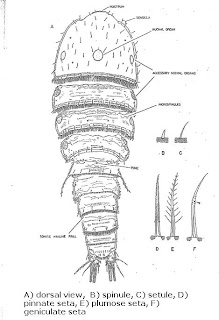Limbs and/or the body surface are ornamented with various structures. A thorn is a more or less pointed projection of the integument itself. A seta, which is flexible and a spine, which is rigid, are similar in that each is inserted into a hole passing through the integument; each has a central, hollow, core and the position of each is constant for a species and sex. Setules and spines are borne on the outer surface of the integument and leave only tiy scar, nota hole, when they fall off. Spines and seta may each have one or more rows of setules and/or spinules (pinnules) and therefore may be described as unipinnate, bipinnate, tripinnate or multipinnate. Seta with hair-like pinnules are commonly described as plumose. The body surface is often covered with minute sensilla, fine hair-like filaments projecting through the cuticle, and other features as pores, microspinules and microsetules.
The cephalosome bears six (seven if it is a cephalotorax) pairs of appendages? Antennules, antennae, mandibles, maxillules, maxillae and maxillipeds. A rostrum usually projects forward between the antennules from at the anterior margin of the cephalic shield.
The cephalosome bears six (seven if it is a cephalotorax) pairs of appendages? Antennules, antennae, mandibles, maxillules, maxillae and maxillipeds. A rostrum usually projects forward between the antennules from at the anterior margin of the cephalic shield.




No comments:
Post a Comment